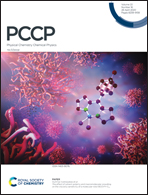A comparative study of semi-flexible linear and ring polymer conformational change in an anisotropic environment
Abstract
We adopt a Langevin-dynamics based simulation to systematically study the conformational change of a semi-flexible probed polymer in a rod crowding environment. Two topologically different probed polymer types, linear and ring polymers, are specifically considered. Our results unravel the significance of the interplay of probed polymer's semi-flexibility and crowding anisotropy. Firstly, both ring and linear polymers show a non-trivial dimensional change including nonmonotonicity and collapse–swelling crossover as their stiffness increases. Secondly, we modulate rod crowder length to investigate the anisotropic effect. We reveal that the formation of an ordered parallel arrangement of the environment can effectively lead to a remarkable stretching effect on the probed polymer. The coupling between the crowding anisotropy-induced stretching and the polymer stiffness can account for the unusual swelling behavior. Lastly, nonmonotonic swelling and shape change of the ring polymer are analyzed. We find out that the ring polymer is subject to most pronounced swelling at robust stiffness. Moreover, the maximum prolate shape is also observed at the same robust location.



 Please wait while we load your content...
Please wait while we load your content...